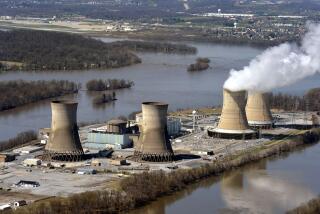Regulators vote to shut down Diablo Canyon, California’s last nuclear power plant
The last remaining nuclear power plant in California will begin shutting down operations in six years as part of a plan approved Thursday by state regulators.
“We chart a new energy future by phasing out nuclear power here in California,” Michael Picker, president of the California Public Utilities Commission, said prior to the 5-0 vote. “We agree the time has come.”
The nuclear plant’s operator, Pacific Gas & Electric, in 2016 announced an agreement with a collection of environmental and labor groups to shut down the plant, which has delivered electricity since 1985.
The utility said Diablo Canyon would be uneconomical to run in the near future because of changes in California’s power grid — specifically, the growth of renewable energy sources, increased energy efficiency measures and the migration of more customers from traditional utilities to new local suppliers under the state’s community choice aggregation program.
Diablo Canyon had been the last remaining nuclear plant in the state, after the San Onofre Nuclear Generating Station closed its doors in January 2012 following a small radiation leak from a steam generator.
Although California soon will have no nuclear plants in operation, there are 99 other nuclear reactors operating in the United States.
Under Thursday’s decision, Unit 1 will close in 2024, and Unit 2 is scheduled for retirement in 2025, the years the federal licenses for the respective units expire.
Located on a bluff overlooking the Pacific Ocean in San Luis Obispo County, Diablo Canyon generates almost 18,000 gigawatt-hours of power each year, powering 1.7 million homes.
According to the most recent figures from the California Energy Commission, nuclear power accounted for about 9% of the state’s power mix, without producing greenhouse gases.
Supporters of nuclear energy said closing Diablo Canyon will cause the state to use more natural gas to replace the electricity generated by the plant.
“I’m sorely disappointed the CPUC has neglected the ratepayers and the environment,” said Gene Nelson, government liaison with Californians for Green Nuclear Power. “Solar and wind cannot be counted on. … They’re subject to random interruptions.”
Environmental groups hailed the decision, which was expected after 17 months of filings and debate, but also were concerned about what type of energy sources would be used to replace Diablo’s electricity.
“We really have to make sure that as we’re phasing out and getting rid of our nuclear power that we’re not replacing it with dirty and dangerous fossil fuels like natural gas and that we’re moving to a 100% clean, renewable economy,” said Dan Jacobson, state director of Los Angeles-based Environment California.
Commissioners expressed confidence that won’t happen.
“There’s no retreat from our strong commitment to our GHG [greenhouse gas] reduction goals,” Commissioner Cliff Rechtschaffen said.
Commissioners approved a proposed decision outlined by a PUC administrative law judge that would give PG&E less money than it wanted to keep staff and retrain the plant’s 1,500 employees as Diablo Canyon gets decommissioned.
PG&E originally wanted $363.4 million, but the commission reduced that to $222.6 million. PG&E will receive $18.6 million from ratepayers for costs associated with licensing from the federal government’s Nuclear Regulatory Commission.
A number of parties in the case, as well as PG&E, proposed $85 million to compensate the community surrounding the plant for the loss of tax dollars that would accompany the closure of the facility.
Commissioners acknowledged the plant’s economic effect on the area, but they said questions involving tax dollars are the responsibility of the state Legislature.
“We are very disappointed that this program was not approved,” PG&E spokesman Blair Jones said, adding that the utility will meet with the parties it worked with in 2016 to determine what do next.
Nikolewski writes for the San Diego Union-Tribune.
More to Read
Inside the business of entertainment
The Wide Shot brings you news, analysis and insights on everything from streaming wars to production — and what it all means for the future.
You may occasionally receive promotional content from the Los Angeles Times.











